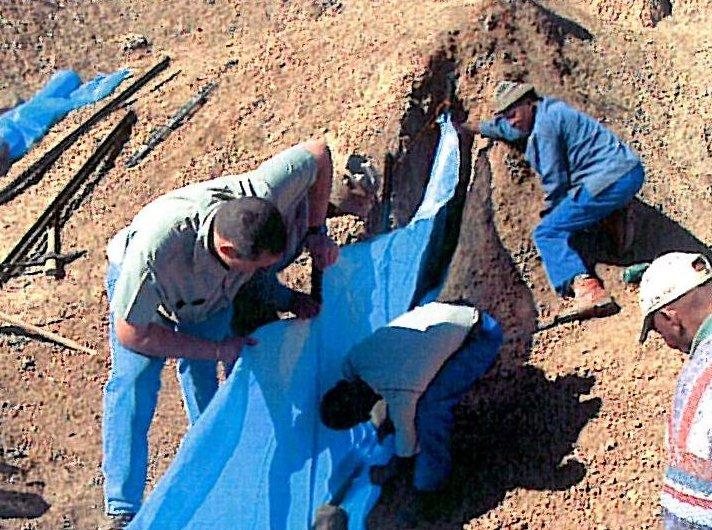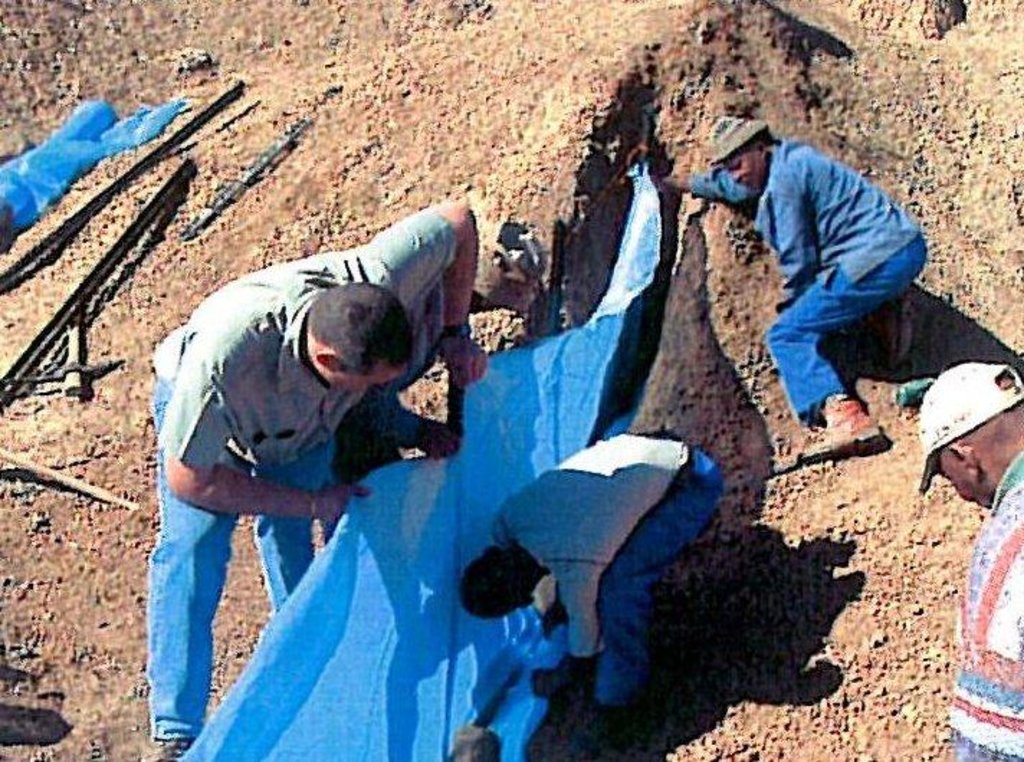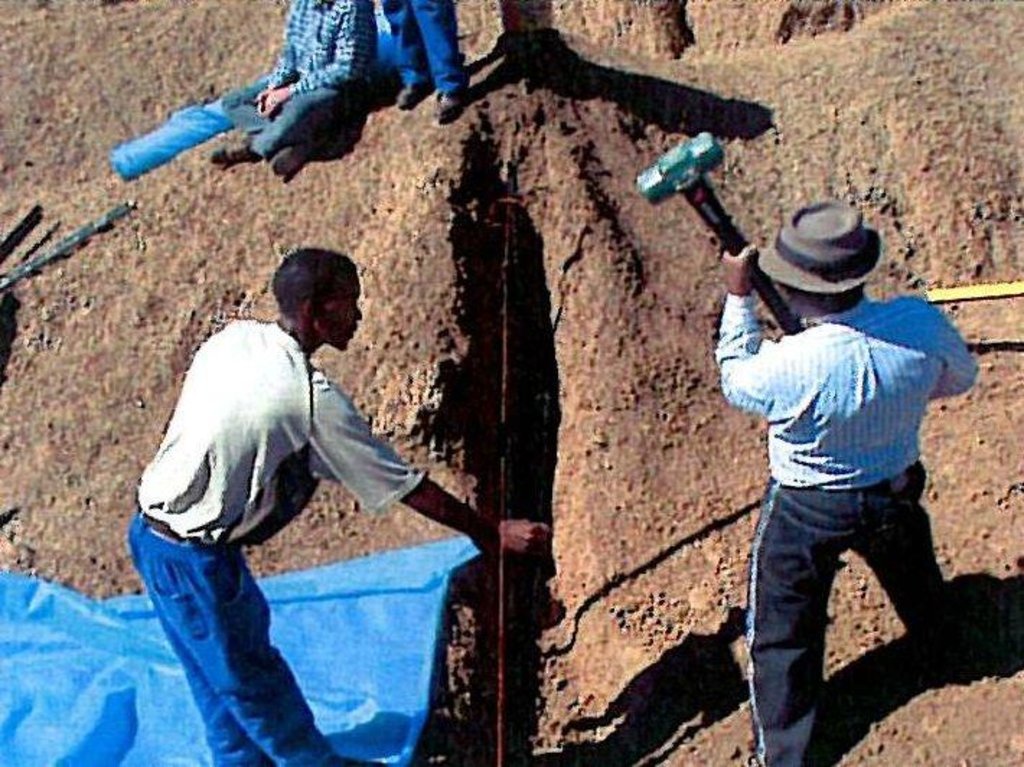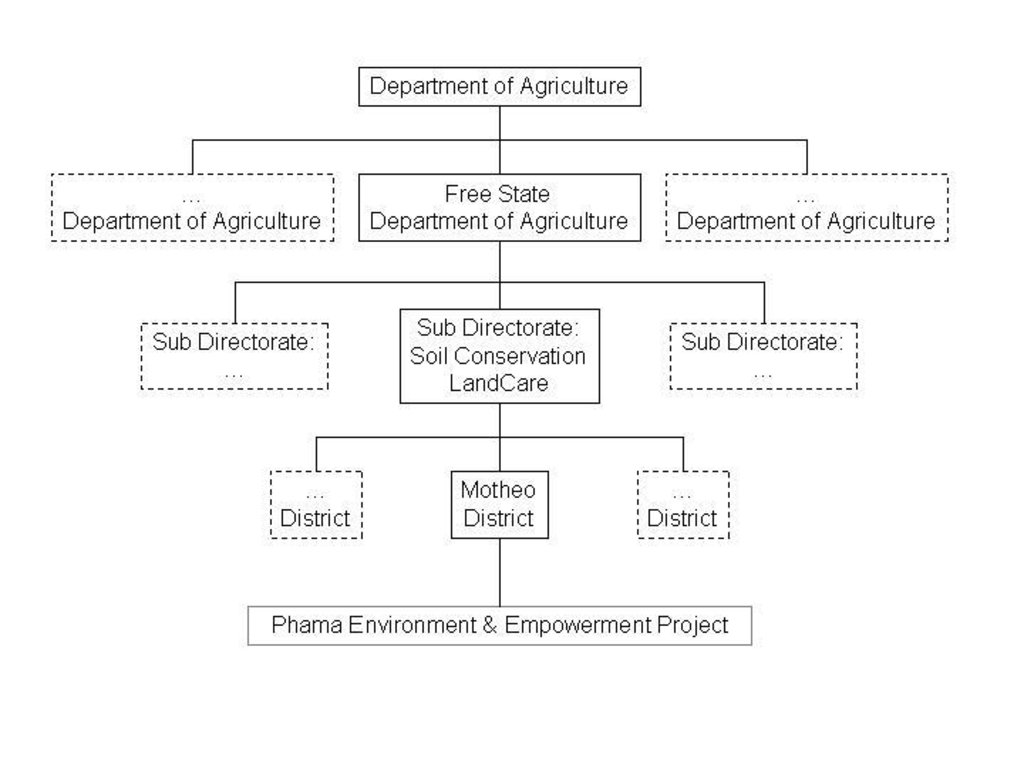Alternative and cost effective methods to control soil erosion [جنوب أفريقيا]
- تاريخ الإنشاء:
- تحديث:
- جامع المعلومات: Christiann Smith
- المحرر: –
- المُراجع: Fabian Ottiger
approaches_2654 - جنوب أفريقيا
عرض الأقسام
توسيع الكل طي الكل1. معلومات عامة
1.2 تفاصيل الاتصال بالأشخاص الرئيسيين لمصدر المعلومات والمؤسسات المعنية بتقييم وتوثيق النهج
1.3 الشروط المتعلقة باستخدام البيانات الموثقة من خلال WOCAT
يوافق جامع المعلومات والشخص (لاشخاص) الرئيسي لمصدر المعلومات على الشروط المتعلقة باستخدام البيانات الموثقة من خلال WOCAT:
نعم
2. وصف نهج الإدارة المستدامة للأراضي
2.1 وصف موجز للنهج
Alternative and cost effective methods to control soil erosion
2.2 وصف تفصيلي للنهج
وصف تفصيلي للنهج:
Aims / objectives: Research alternative, cost effective measures to control soil erosion Training of potentail contractor to errect soil conservation structures (Black Economic Empowerment) Wider acceptance and adoption of techniques by neighbouring communities
Methods: On-site research Literature research Needs analysis Trial and error Awareness ampaigns and information days Job creation to build structures
Stages of implementation: Control invader plants Literature research Design small structures Construction of erosion structures and stock watering Research on run-off trials Data analysis Information sharing
Role of stakeholders: Construction of small structures, controll invader plans, construction of stock watering
2.3 صور عن النهج
2.5 البلد/المنطقة/المواقع التي تم تطبيق النهج فيها
البلد:
جنوب أفريقيا
المنطقة/الولاية/المحافظة:
South Africa / Free State
مزيد من التفاصيل حول الموقع:
Ladybrandt
2.6 تواريخ بدء وإنهاء تنفيذ النهج
أشر إلى سنة البدء:
2006
سنة الإنهاء (إذا لم يعد النهج مطبقًا):
2009
2.7 نوع النهج
- قائم على مشروع/برنامج
2.8 الغايات/الأهداف الرئيسية للنهج
The Approach focused mainly on SLM with other activities (Control invader and alien plants)
Research alternative, cost effective measures to control soil erosion Training of potentail contractor to errect soil conservation structures (Black Economic Empowerment) Wider acceptance and adoption of techniques by neighbouring communities
The SLM Approach addressed the following problems: Soil erosion Lost of grazing due to invader and alien plants Over grazing Lack of stock / grazing management Lack of knowledge
2.9 الظروف التي تمكن أو تعيق تنفيذ التقنية/التقنيات المطبقة بموجب النهج
توفر/الوصول إلى الموارد والخدمات المالية
- معيق
Community has limited financial resource for conservation
Treatment through the SLM Approach: Project will provide funding for implementation of structures
الإطار القانوني (حيازة الأراضي، وحقوق استخدام الأراضي والمياه)
- معيق
The existing land ownership, land use rights / water rights moderately hindered the approach implementation Stock owners association rules was too rigid and land users are not owners (communage) - no private ownership. Members of cattle association differ.
المعرفة حول الإدارة المستدامة للأراضي، والوصول إلى الدعم الفني
- معيق
Community does not have technical know-how to design small structures
Treatment through the SLM Approach: Project provides technical inpust
غير ذلك
- معيق
Knowledge: Little knowledge about cost-effective measures to control soil erosion
Treatment through the SLM Approach: Project will provide funding for implementation of structures
3. المشاركة وأدوار الأطراف المعنية
3.1 أصحاب المصلحة المعنيون بالنهج وأدوارهم
- مستخدمو الأراضي المحليون/المجتمعات المحلية
Stock owners, contractors and community members
Men will do more physical work like building rock structures or fitting of rock gabions
- متخصصون في الإدارة المستدامة للأراضي / مستشارون زراعيون
- الحكومة الوطنية (المخططون، صانعو القرار)
Provincial Department of Agriculture technical officials
- منظمة دولية
3.2 انخراط مستخدمي الأراضي المحليين/المجتمعات المحلية في المراحل المختلفة للنهج
| انخراط مستخدمي الأراضي المحليين/المجتمعات المحلية | حدد من شارك وصف الأنشطة | |
|---|---|---|
| المبادرة/التحفيز | سلبي | |
| التخطيط | سلبي | |
| التنفيذ | الدعم الخارجي | |
| الرصد/التقييم | تفاعلي | |
| Research | غير موجود |
3.3 مخطط التدفق (إذا كان متاحًا)
3.4 اتخاذ القرار بشأن اختيار تقنية/تقنيات الإدارة المستدامة للأراضي
حدد من الذي قرر اختيار التقنية/التقنيات التي سيتم تنفيذها:
- متخصصون في الإدارة المستدامة للأراضي بشكل أساسي، بعد التشاور مع مستخدمي الأراضي
اشرح:
Decisions on the method of implementing the SLM Technology were made by mainly by SLM specialists with consultation of land users
4. الدعم الفني وبناء القدرات وإدارة المعرفة
4.1 بناء القدرات/التدريب
هل تم تقديم التدريب لمستخدمي الأراضي / الأطراف المعنيين الآخرين؟:
نعم
- land user
شكل التدريب:
- مناطق العرض
- اجتماعات عامة
- دورات
المواضيع المغطاة:
Construction of SWC structures and training on veld management. Control of invader plants.
4.2 خدمة استشارية
هل يملك مستخدمو الأراضي وصولا إلى خدمة استشارية؟:
نعم
حدد ما إذا كانت الخدمة الاستشارية متوفرة:
- في حقول مستخدمي الأراضي
وصف/تعليقات:
Name of method used for advisory service: Cost effective erosion control and veld management; Key elements: Awareness, Meetings formal and informal, Farm visits and participatory approaches
Advisory service is quite adequate to ensure the continuation of land conservation activities; Empowered through project to continue with SWC activities
4.4 الرصد والتقييم
هل يشكل الرصد والتقييم جزءا من النهج؟:
نعم
التعليقات:
technical aspects were regular monitored through measurements; indicators: Functionaing (effectiveness) of structures
socio-cultural aspects were ad hoc monitored through observations; indicators: Adoption of technology
area treated aspects were regular monitored through measurements; indicators: Area treatede / conserved
no. of land users involved aspects were regular monitored through measurements; indicators: No. of community actively involved
management of Approach aspects were regular monitored through measurements; indicators: Maintenance and acceptance
There were few changes in the Approach as a result of monitoring and evaluation: Redesign of small structures and different application of materials
4.5 البحوث
هل كانت البحوث جزءًا من النهج؟:
نعم
حدد المواضيع:
- علم الايكولوجيا
أعط تفاصيل إضافية وأشر إلى من قام بالبحوث:
Run-off trials and participatory approaches for community participation
Research was carried out on-farm
5. التمويل والدعم المادي الخارجي
5.1 الميزانية السنوية لمكون الإدارة المستدامة للأراضي في النهج المذكور
إذا لم تكن الميزانية السنوية الدقيقة معروفة، قم بالإشارة إلى نطاقها:
- 1,000000-100،000
التعليقات (على سبيل المثال المصادر الرئيسية للتمويل/الجهات المانحة الرئيسية):
Approach costs were met by the following donors: government (Agricultural Research Council): 80.0%; national non-government: 15.0%; local community / land user(s): 5.0%
5.2 الدعم المالي/المادي المقدم لمستخدمي الأراضي
هل حصل مستخدمو الأراضي على دعم مالي/ مادي لتنفيذ التقنية/ التقنيات؟:
نعم
5.3 إعانات لمدخلات محددة (بما في ذلك العمالة)
- معدات
| حدد المدخلات التي تم دعمها | إلى أي مدى | حدد الإعانات |
|---|---|---|
| الآلات | ممول جزئيا | |
| أدوات | ممول جزئيا | |
- زراعة
| حدد المدخلات التي تم دعمها | إلى أي مدى | حدد الإعانات |
|---|---|---|
| بذور | ممول بالكامل | |
| أسمدة | ممول بالكامل | |
| Biocides | ممول بالكامل | |
إذا كان العمل من قبل مستخدمي الأراضي مدخلاً جوهريًا، فهل كان:
- مدفوع نقدا
التعليقات:
Grant paid for labour
Material for SWC structures were fully financed
5.4 الائتمان
هل تم توفير ائتمان في إطار نهج أنشطة الإدارة المستدامة للأراضي؟:
كلا
6. تحليل الأثر والتصريحات الختامية
6.1 آثار النهج
هل ساعد النهج مستخدمي الأراضي على تنفيذ وصيانة تقنيات الإدارة المستدامة للأراضي؟:
- لا
- نعم، قليلا
- نعم، باعتدال
- نعم، إلى حد كبير
Use of silt fences and soil boxes adapted by land users
هل أدى النهج إلى تحسن في مسائل حيازة الأراضي / حقوق المستخدمين التي أعاقت تنفيذ تقنيات الإدارة المستدامة للأراضي؟:
- لا
- نعم، قليلا
- نعم، باعتدال
- نعم، إلى حد كبير
Improve general awareness and commitment of cattle owners The problem is unlikely to be overcome in the near future. Too many people - too much pressure on the land and unwillingness of local authorities to get involved.
Did other land users / projects adopt the Approach?
- لا
- نعم، قليلا
- نعم، باعتدال
- نعم، إلى حد كبير
Commercial farmers who visited project adopted and implemented some of the SWC methods deomnstrated / researched in projects.
6.4 نقاط قوة/مزايا النهج
| نقاط القوة/ المزايا/ الفرص من وجهة نظر مستخدمي الأراضي |
|---|
| Temporary job creation (How to sustain/ enhance this strength: Not sustainable if there are no follow up projects) |
| Improved natural resource condition (How to sustain/ enhance this strength: Maintain structures / control invasive plants / implement grazing system) |
| Contractor empowered with unique SWC methods - niche market (How to sustain/ enhance this strength: Continue empowerment with training and informatin sharing. He has to advertise his services.) |
| نقاط القوة/ المزايا/ الفرص من وجهة نظر جامع المعلومات أو غيره من الاشخاص الرئيسيين لمصدر المعلومات |
|---|
| Empowerment of community with knowledge and skills (How to sustain/ enhance this strength: Ensure the adaption and implementation of structures and maintenance of current structures) |
| Empowerment of contractor (How to sustain/ enhance this strength: Follow up projects and work for private sector) |
| Holistic approach towards environmental problems (How to sustain/ enhance this strength: systems approach deal with real causes of degradation. More partnerships and more stakholders involved.) |
| Cost effective methods to control soil conservation (How to sustain/ enhance this strength: More on-site research andawareness of test method technologies and approaches.) |
| Alien plant control (How to sustain/ enhance this strength: Follow up and more research monitoring and evaluation) |
| Improved veld management (How to sustain/ enhance this strength: Monitoring and evaluation) |
6.5 نقاط الضعف/ العيوب في المنهج وطرق التغلب عليها
| نقاط الضعف/ المساوىء/ المخاطر من وجهة نظر مستخدم الأراضي | كيف يمكن التغلب عليها؟ |
|---|---|
| No ownership of land (land tennure - commonage) | Review use of commonages - need new policy |
| Low educational levels - difficalt to train, learn new technologies | Continue education, training and awareness |
| Contractor needs administrative empowerment | Capacity building |
| نقاط الضعف/ المساوىء/ المخاطر من وجهة نظر جامع المعلومات أو غيره من الاشخاص الرئيسيين لمصدر المعلومات | كيف يمكن التغلب عليها؟ |
|---|---|
| Lack of local expertise in SWC structures / small structures | Continue with researh and information shareing at national / international level. |
| Capacity on project management side | More and better trained project managers. |
| Financial support: Huge problem - small budget | Convince national donors about extent and degree of degradation problems. Look for private donors. |
| Politics exclude commercial farmers - project coud have bigger impact | Decision for restoration and conservation must be based on ecological needs and not political agendas. |
7. المراجع والروابط
7.1 طرق جمع/مصادر المعلومات
- زيارات ميدانية، مسوحات ميدانية
- مقابلات مع مستخدمي الأراضي
الروابط والوحدات المواضيعية
توسيع الكل طي الكلالروابط
لا يوجد روابط
الوحدات المواضيعية
لا يوجد وحدات مواضيعية






